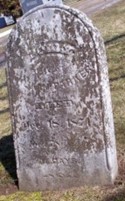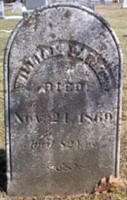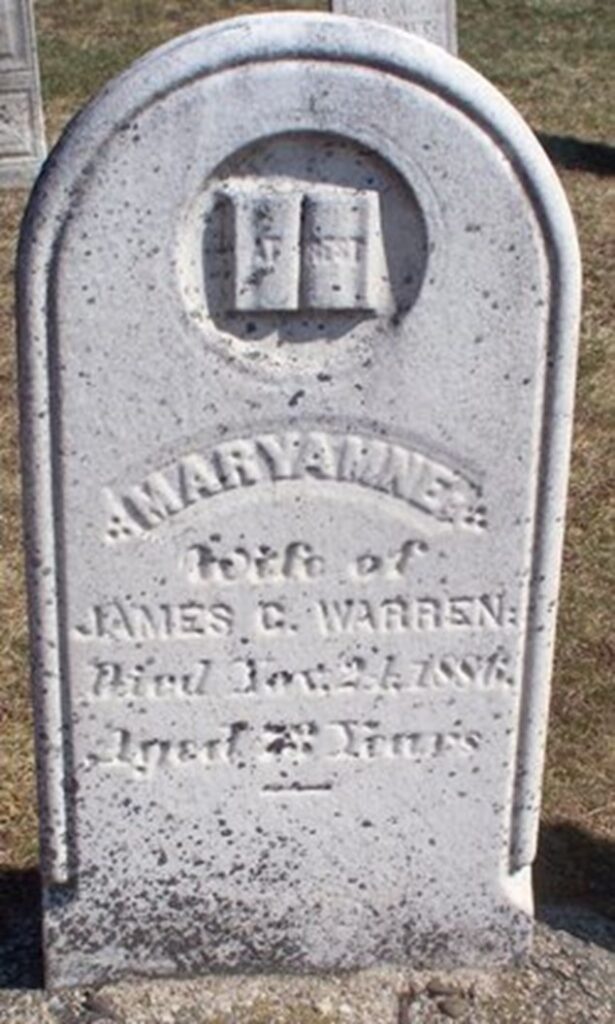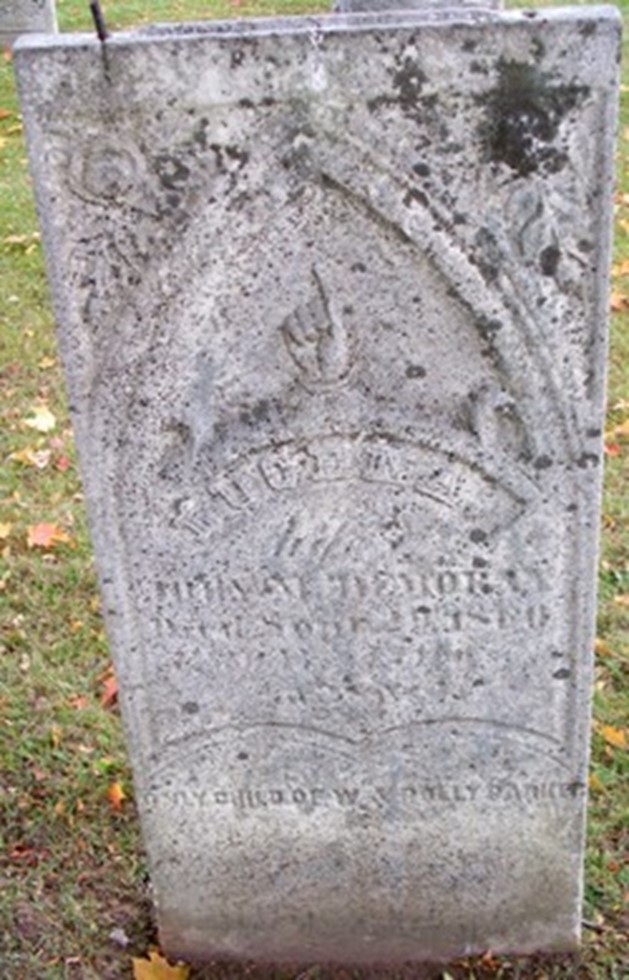

Polly (Mary) Harris, daughter of Rufus Harris and Lucy Hill, was born on March 8, 1794 in Smithfield, Providence County, Rhode Island. She was the sister of Lucy Harris.
Smithfield, one of the largest communities in Rhode Island, was home to the Harris family for three generations. There, the family made a bountiful living by working in the quarries.
In 1804, at age ten Polly moved to Palmyra with her siblings and widowed mother, who sold her estate in Rhode Island. By moving to Palmyra, Polly was able to associate with her older brothers Paul and Peter, who had been residents of the village since 1800, and her uncle Nathan Harris and Aunt Rhoda Harris (parents of Martin Harris), who had been residents since 1796.
It was in Palmyra that Polly met Freeman Cobb, the eighth child of Syvanus Cobb and Elizabeth Warren, born on September 3, 1784 in Conway, Franklin County, Massachusetts. Freeman had moved to Ontario, New York in the early 1800s and was listed as an adult living with his older brother John Merrie Cobb by 1810.
Notice of the upcoming marriage of Polly and Freeman appeared in the January 3, 1812 issue of the Geneva Gazette. They were married on May 19, 1812 in Palmyra. Soon after their marriage, Freeman was recruited as a citizen/soldier in the War of 1812. He fought in skirmishes and battles along the Canadian frontier. After completing his military stint, Freeman and Polly resided in Williamson, New York on the south shore of Lake Ontario, twelve miles from Palmyra. The small hamlet of Williamson enjoyed prominence as a port town until the opening of the Erie Canal in 1823.
In Williamson, Freeman and Polly had two children—Marianne Cobb, born on December 9, 1813 and Duty Cobb, born in 1818. Freeman supported his family by working aboard schooners on Lake Ontario. Eight years after their marriage, Freeman’s name appeared on the records of the Christian Church at Marion, Wayne County, New York. At that time, Elisha Warren Cobb, a brother of Freeman, was living in Palmyra. That would have given Polly and Freeman another reason to visit Palmyra besides visiting Polly’s relatives.
Why Polly Harris Cobb moves in with Martin and Lucy Harris
On December 12, 1821, the schooner Atlas, carrying a cargo of barreled pork, cider, and lard, departed from Pultneyville, New York on Lake Ontario bound for Ogdensburgh, New York, situated on the St. Lawrence River. The crew of the Atlas consisted of five men, including Freeman Cobb, the husband of Polly Harris Cobb, and Seth Harris, the brother of Polly Harris Cobb. During a severe winter gale on the night of December 13, 1821, the Atlas was wrecked, and all hands went to a watery grave. The Western Farmer printed a notice of the total destruction of the Atlas: “The vessel, dismasted and with her deck and cabin carried away, with nothing remaining but her hull, was driven on shore, on the 13th ult. near the mouth of Sand Creek, at Ellisburgh, Jefferson County.”[1]
Members of the extended Harris family, interlinked by birth and marriage, were greatly impacted by news of the tragic event. Seth Harris had married his first cousin, Sophia Harris, the daughter of Nathan and Rhoda Harris and sister to Martin Harris. Freeman Cobb was the brother-in-law of Martin Harris.
Martin Harris and Reuben Hewitt were appointed administrators of the Seth Harris estate.[2] The administrators found outstanding debts and demands against the Seth Harris estate. There was a debt of $1,449 “over and above the assets remaining.” Administrators were authorized by the court to sell the Seth Harris lands in Williamson to pay the debt. The Seth Harris mill and mill pond were sold at a public auction to help erase the debt. The court appointed Peter Harris as guardian of Seth’s four minor children—Anna, Melinda, Daniel and Naomi.
In 1822, Freeman’s widow, Polly Harris Cobb, and her children were taken into the Martin and Lucy Harris home. For six years, Polly and her children resided in that home until her marriage in 1828. By moving in with the Martin Harris family, Polly became a near neighbor to her brother Peter and her sister-in-law, Sophia. Polly may have worshipped with the Quakers in the area, for they met at the home of her brother Peter. However, Polly’s subsequent marriage by a Presbyterian preacher suggests otherwise.
Martin Harris builds Bigger House
With the addition of Polly and her children in his house, Martin Harris turned his attention to building a new and larger home. The anticipated building project was expansive and beyond the grasp of less fortunate citizens in Palmyra, but not for Martin Harris. In the early 1820s, Martin Harris was “an industrious, hardworking farmer, shrewd in his business calculations, frugal in his habits, and what was termed a prosperous man in the world.”[3] The new home was a spacious frame house of eight or more rooms. (The Martin Harris farmhouse burned to the ground in 1849. It was replaced by a cobblestone house which is on the property today. The address of the cobblestone house is Martin Harris Farm, RD 2-A Maple Avenue, Palmyra.)
The beautiful farmhouse was nearly finished by 1824. Only a few details remained—rocking up a well on the east side of the kitchen entrance and walling up the basement. To accomplish these minor tasks, Martin employed Joseph Smith Sr. and his son Hyrum Smith in the spring of 1824. Each day as they labored, Martin found an excuse to bring up the matter of young Joseph Smith and rumors surrounding his visions:
. . . and would ask many questions, referring frequently to the Bible to prove that heavenly messengers visiting the earth, was not a new doctrine. Finally, during the course of their conversations, Mr. Smith took Martin into his confidence and told him of Joseph’s wonderful experience with the angel Moroni. Martin was thrilled beyond expression. He requested that he be kept posted on any new developments.[4]
We can assume that Polly Harris Cobb knew of the conversations between Martin Harris and Joseph Smith Sr. as early as 1824.
At the insistence of Lucy Harris, Lucy and Martin entered into a legal agreement to transfer 80 acres and a house on the northwest portion of the Martin Harris farm from Martin to Lucy in 1825. To fulfill requirements of the New York common law, which would not allow a direct transfer of property from a husband to his wife, on November 29, 1825 Martin deeded the said acreage to Peter Harris, his brother-in-law. That same day, Peter deeded the said acreage and home to his sister Lucy Harris. Lucy Harris did not move into the house in 1825—she moved into the home in May 1828.
The following incident occurred in the Martin Harris home—
In late September or early October 1827, Joseph Smith asked his mother to go to the Harris home and tell Martin Harris to come and meet with him. The errand appeared simple enough, but not for Mother Smith. She wrote, “This, indeed, was an errand which I much disliked.” Mother Smith said to Joseph, “I would rather not go, unless I could have the privilege of speaking to her [Lucy Harris] first upon the subject. To this he consented, and I went according to his request.”[5]
When Mother Smith arrived at the Harris home, she “cautiously detailed the particulars with regard to Joseph’s finding the plates, so far as wisdom dictated and necessity demanded, in order to satisfy Mrs. Harris’s curiosity.” Her brief narrative provoked a most curious reaction in Lucy Harris and Polly Cobb. Polly “desired me [Lucy Smith] to receive an amount of money, I think some seventy-five dollars, to assist in getting the Record translated.”[6]
Attempting to sway the discussion to her own purpose, Mother Smith said to Lucy Harris, “I came on no such business, that I did not want her money, and that Joseph would attend to his own affairs; but, that I would like to talk with Mr. Harris for a moment, and then return home, as my family would soon be expecting me.” Lucy Harris was “determined to assist in the business, for she said she knew that [Joseph] should want money, and she could spare two hundred dollars as well as not.” After detaining Mother Smith a few minutes longer, Lucy Harris escorted Mother Smith to where Martin was working on a fireplace.
The Year 1828
Martin Harris “arranged his affairs,” and left Palmyra on “about the 12th of April, 1828” and returned to the Smith home in Harmony, Pennsylvania. After Martin’s departure—
[Lucy Harris went] from house to house, telling her grievances, and declaring that Joseph Smith was practising [sic] a deception upon the people, which was about to strip her of all that she possessed, and that she was compelled to deposit a few things away from home in order to secure them. So she carried away her furniture, linen, and bedding; also other movable articles, until she nearly stripped the premises [Martin’s house] of everything that could conduce either to comfort or convenience, depositing them with those of her friends and acquaintances, in whom she reposed sufficient confidence to assure her of their future safety.[7]
The property transaction made on November 29, 1825, deeding 80 acres to Lucy Harris via her brother Peter Harris, was not officially recorded until May 13, 1828. It was then that Lucy began to gather her furniture, etc. from close friends and moved into the house at 2827 Macedon Center Road in Palmyra. It is assumed that Polly and her children moved from the Martin Harris home to the Lucy Harris home in May of 1828.
In the meanwhile, Martin scribed the Book of Lehi as dictated by the Prophet Joseph Smith and asked to take the manuscript with him to Palmyra. Martin was told that only a limited number of family members could view the manuscript, namely “his brother, Preserved Harris, his wife [Lucy Harris], his father [Nathan Harris], his mother [Rhoda Lapham Harris], and a Mrs. Cobb [Polly Harris Cobb], a sister to his wife.” In mid-June 1828, Martin carried the manuscript to Palmyra.
Soon after returning to his home in mid-June 1828, Martin took his wife Lucy to visit her relatives, some ten to fifteen miles distance from Palmyra. The only relative of Lucy that lived within the distance of 10 to 15 miles from Palmyra was her brother Levi Harris and his family. They resided in Farmington, New York—the heart of the Quaker community in Western New York.
Levi Harris was born on July 6, 1781 in Smithfield, Rhode Island. He sold one-tenth of his inheritance, a farm in Smithfield to Jeremiah Smith for $33l.15 in 1803.[8] With money in hand, he joined his brothers—Peter and Paul Harris—in Palmyra. In 1806, he purchased 115 acres from Isaac Kelly. He moved from Palmyra to Farmington. Martin’s stay with Lucy’s relatives was brief, for he had pressing business matters and a jury duty obligation in Palmyra. As he made preparations to return to Palmyra, Lucy wished to extend her visit and declined to accompany him. Surely, Lucy shared with her brother Levi her distress over Martin’s connection with Joseph Smith.
Did Martin return to Farmington to pick up Lucy? We assume that Levi brought Lucy back to Palmyra so they both could attend the wedding of their sister, Polly Harris Cobb to William Parker on Thursday, July 3, 1828. Polly and William were married in Palmyra by Reverend William Blakesley. (Reverend Blakesley was the same man who married Flanders Dyke and Lucy Harris in May 1828). Notice of their marriage appeared in the July 4, 1828 issue of the Wayne Sentinel.
Let’s talk about the wedding and the possible connection to the theft of the manuscript. We know that to miss a family wedding, you need to have a really good excuse. As we think about the 116 pages being stolen, although Martin took Lucy to visit her brother Levi Harris in Farmington, there were still many people in the Harris homes. More and more people would gather in the homes as the wedding festivities drew near—Harris and Lapham relatives as well as relatives of William Parker. When would the two homes be vacant for the theft to occur?
Polly and William were married in a chapel on Main Street—about three miles from the Harris homes. When was the only time that people would not be running in and out of the two Harris homes? When was the best time to steal the pages and not get caught or be seen? During the wedding! Who in the wedding party could not show up for the wedding and not be missed? Flanders Dyke, or another guest?
The day after the wedding was Friday, July 4, 1828. Independence Day in Palmyra was a huge patriotic event that lasted all day. People came from miles around to participate in the celebration, which included military parading, games, races, food, and dancing. Visitors who came for the wedding of Polly and William surely stayed over the next day to participate in the patriotic festivities.
Martin Harris, an industrious man about town, had spent two full days with the wedding festivities and the patriotic celebrations. By July 5, it was time for him to return to his many business affairs. We do not see Martin showing the manuscript pages to anyone from July 3 to July 6. He had other things on his mind. On Monday July 7, 1828, Martin Harris learned that Joseph Smith was in Palmyra and wanted him to bring the manuscript to the Smith home. On July 7, Martin knew the manuscript was gone.
Did Polly take the pages? Did Lucy Harris give the pages to her sister Polly after she discovered her bureau had been marred? The close bond between Lucy and her sister Polly is undeniable. Polly would be a good go-between because she could not read or write, as evidenced by the “X” signed on her Last Will and Testament.
Polly and her husband William Parker move from Palmyra
Soon after their marriage, Polly and William moved to Venice, Orleans County, New York, on the south shore of Lake Ontario, about 57 miles from Palmyra. Also moving to Orleans County was Polly’s brother, Levi Harris. Were they in league as to the missing manuscript? We do not think so. In August 1830, Polly gave birth to her only child with William Parker, Lucena Parker, in Orleans County. After the birth, Polly, William, and their baby moved to Hartland, 76 miles from Palmyra.
In spite of the growing distance from the Harris family in Palmyra, diary entries of Mary Durfee suggest that Polly returned often to Palmyra. It is assumed that she returned for the funeral of her sister Lucy Harris in 1836. On August 13, 1837, Mary Durfee penned, “Polly Harris came here.” On March 30, 1839, “Polly H. is here–I am spinning flax.” On September 17, 1839, Mary wrote, “Polly Harris is here.”[9]
Residents of Newfane, New York
When Polly and her family moved to Newfane, Niagara County, New York, any visits to Palmyra went unrecorded. Newfane is a quaint community located along the scenic shores of Lake Ontario. Newfane was also the residence of Polly’s daughter, Marianne Cobb, and her son, Dutee Cobb. Both Marianne and Dutee married and each became the parents of seven children. Dutee enlisted in Company 3 of the 193rd New York Volunteers to fight in the Civil War. After the war, he returned to Newfane.
In 1849, administrators of the Peter Harris estate informed Polly of the death of her brother, Peter Harris, on December 7, 1849. Peter had no descendants. On February 9, 1850, Polly and her husband received notice of an inheritance from the Peter Harris estate. On November 18, 1850, Polly was paid $100 “on account of being bequeathed by the will of the deceased.” She later received $70.32 from the same executors. On November 15, 1851, Polly was served a citation on her portion of the inheritance from the Peter Harris estate.[10]
Between 1850 and 1852, Polly was residing with her husband William Parker, age sixty-three, and their daughter Lucine, age twenty, in Newfane. William supported the family as a farmer.[11] In the 1865 US Federal Census, William Parker was listed as age seventy-seven and Polly age seventy-one. At that time, they resided in a frame house valued at $1,000. In 1869, the Niagara County Directory listed William Parker as a farmer residing on Lot 17.
On November 24, 1869 William Parker died at age eighty-one. He was buried in the Corwin Cemetery in Newfane. In his Last Will and Testament, William did not name his widow Polly as a beneficiary. This is curious. William named only his nieces, children of Asael and Nancy Warren Parker—Livona Parker, Lara Weld, and Velina Weld—as beneficiaries. William Parker was buried in the south east section in Lot 322 in the Corwin Cemetery.[12]
Death of Polly Harris Cobb Parker
On December 18, 1871, Polly Harris Cobb Parker died in Newfane. She was buried in the Corwin Cemetery, the same cemetery as her late husband William Parker. The first executor of her estate, Anthony McKee, was replaced by Barnabus Warren. The reason for McKee being renounced was dissatisfaction over the manner in which he handled the estate. In her will, Polly bequeathed to her daughter, Marianne Warren, $1,000. To her son, Dutee Cobb, she bequeathed her personal estate. To her granddaughters (children of Dutee Cobb), she bequeathed personal possessions. Polly left instructions for her executors to pay off the debts of her late husband that encumbered her estate. She signed her will with an “X,” suggesting that she could not read or write. Her will was affixed by the seal of the Surrogates Office on February 5, 1872.
Children of Polly and Freeman Cobb
1. Marianne Cobb (1813–1886). She was born on December 9, 1813 in Williamson, New York. She married James C. Warren (1827) in 1840 in New York. Marianne died on November 29, 1886.

2. Dutee (Duty) Cobb (1817–1888). He was born in 1817 in Williamson, New York. In 1865, he resided in Newfane, New York. In 1880, he resided in Ransomville, New York. He died in 1888 in Ransomville.

Child of Polly Harris Cobb and William Parker
1. Lucena Parker (August 1830–1860). She was born in Orleans County, New York. From 1855 to 1860, she resided in Niagara County, New York. She married John M. Demoray. She died in Niagara County and was buried in the Corwin Cemetery. She was the mother of one son, William P. Demoray (September 11, 1860–April 1, 1862).

[1] “Distressing Event,” Western Farmer [Palmyra, NY], December 26, 1821, p. 3.
[2] See Ontario County Surrogate Court Records, January 5, 1822, in Scott H. Faulring Papers, “Seth Harris Probate Papers 1823,” Documents No. 2316, Box 100, Fd. 3, Manuscripts Division and Special Collections, J. Willard Marriott Library, University of Utah, Salt Lake City; On February 22, 1822 Martin Harris and Reuben Hewett were appointed acting administrators of the Seth Harris estate, see Letters of Administration granted to Martin Harris and Reuben Hewitt, Surrogate’s Probate Records, Book 15, p. 125, Ontario County Surrogate Court Clerk, Canandaigua, NY; see “Surrogate’s Authorization for Land Sale at Public Auction by Administrators,” Wayne Sentinel, October 22, 1823, p. 4.
[3] “Old Newspapers—No. 24,” Palmyra Courier, May 24, 1872.
[4] Bean, A.B.C. History of Palmyra, p. 35; Turner, History of the Pioneer Settlement of Phelps and Gorham’s Purchase, p. 215.
[5] Lucy Mack Smith, History, 1844–1845.
[6] Smith, Biographical Sketches of Joseph Smith, pp. 116–117.
[7] Lucy Mack Smith, History, 1844–1845.
[8] Smithfield Land Records, Book 10, p. 238.
[9] Mary Durfee Diary, August 13, 1837 and September 17 1839.
[10] Wayne Surrogate’s Court—In the Matter of the Estate of Peter Harris, deceased.
[11] Census of the Town of Newfane, NY.
[12] Corwin Cemetery listing in Newfane, NY.
